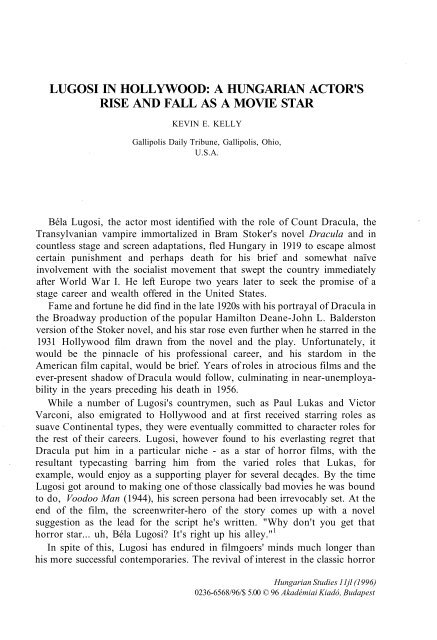HUNGARIAN STUDIES 11. No. 1. Nemzetközi Magyar ... - EPA
HUNGARIAN STUDIES 11. No. 1. Nemzetközi Magyar ... - EPA
HUNGARIAN STUDIES 11. No. 1. Nemzetközi Magyar ... - EPA
- No tags were found...
Create successful ePaper yourself
Turn your PDF publications into a flip-book with our unique Google optimized e-Paper software.
LUGOSI IN HOLLYWOOD: A <strong>HUNGARIAN</strong> ACTOR'SRISE AND FALL AS A MOVIE STARKEVIN E. KELLYGallipolis Daily Tribune, Gallipolis, Ohio,U.S.A.Béla Lugosi, the actor most identified with the role of Count Dracula, theTransylvanian vampire immortalized in Bram Stoker's novel Dracula and incountless stage and screen adaptations, fled Hungary in 1919 to escape almostcertain punishment and perhaps death for his brief and somewhat naïveinvolvement with the socialist movement that swept the country immediatelyafter World War I. He left Europe two years later to seek the promise of astage career and wealth offered in the United States.Fame and fortune he did find in the late 1920s with his portrayal of Dracula inthe Broadway production of the popular Hamilton Deane-John L. Balderstonversion of the Stoker novel, and his star rose even further when he starred in the1931 Hollywood film drawn from the novel and the play. Unfortunately, itwould be the pinnacle of his professional career, and his stardom in theAmerican film capital, would be brief. Years of roles in atrocious films and theever-present shadow of Dracula would follow, culminating in near-unemployabilityin the years preceding his death in 1956.While a number of Lugosi's countrymen, such as Paul Lukas and VictorVarconi, also emigrated to Hollywood and at first received starring roles assuave Continental types, they were eventually committed to character roles forthe rest of their careers. Lugosi, however found to his everlasting regret thatDracula put him in a particular niche - as a star of horror films, with theresultant typecasting barring him from the varied roles that Lukas, forexample, would enjoy as a supporting player for several decades. By the timeLugosi got around to making one of those classically bad movies he was boundto do, Voodoo Man (1944), his screen persona had been irrevocably set. At theend of the film, the screenwriter-hero of the story comes up with a novelsuggestion as the lead for the script he's written. "Why don't you get thathorror star... uh, Béla Lugosi? It's right up his alley." 1In spite of this, Lugosi has endured in filmgoers' minds much longer thanhis more successful contemporaries. The revival of interest in the classic horrorHungarian Studies 11jl (1996)0236-6568/96/$ 5.00 © 96 Akadémiai Kiadó, Budapest
















